Emo is a music genre characterized by emotional, often confessional lyrics. It emerged as a style of hardcore punk and post-hardcore from the mid-1980s Washington, D.C. hardcore scene, where it was known as emotional hardcore or emocore. The bands Rites of Spring and Embrace, among others, pioneered the genre. In the early-to-mid 1990s, emo was adopted and reinvented by alternative rock, indie rock, punk rock, and pop-punk bands, including Sunny Day Real Estate, Jawbreaker, Cap'n Jazz, and Jimmy Eat World. By the mid-1990s, Braid, the Promise Ring, and the Get Up Kids emerged from Midwest emo, and several independent record labels began to specialize in the genre. Meanwhile, screamo, a more aggressive style of emo using screamed vocals, also emerged, pioneered by the San Diego bands Heroin and Antioch Arrow. Screamo achieved mainstream success in the 2000s with bands like Hawthorne Heights, Silverstein, Story of the Year, Thursday, the Used, and Underoath.

Something to Write Home About is the second studio album by American rock band the Get Up Kids, released on September 28, 1999, through Vagrant Records and the band's own label Heroes & Villains Records. Following the promotional tours for their debut album Four Minute Mile (1997), the band were in discussion with Mojo Records. During this period, James Dewees joined as the band's keyboardist. As negotiations with the label eventually stalled, they eventually went with Vagrant Records. They recorded their next album at Mad Hatter Studios in Silver Lake, Los Angeles, California, co-producing it with Chad Blinman and Alex Brahl. Described as an emo album, Something to Write Home About expands on the harder edge of its predecessor, with frontman Matt Pryor citing the works of the Foo Fighters, Jimmy Eat World and Wilco as influences.
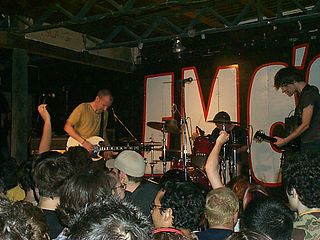
Fugazi was an American post-hardcore band formed in Washington, D.C., in 1986. The band consisted of guitarists and vocalists Ian MacKaye and Guy Picciotto, bassist Joe Lally, and drummer Brendan Canty. They were noted for their style-transcending music, DIY ethical stance, manner of business practice, and contempt for the music industry.

The Get Up Kids are an American rock band from Kansas City. Formed in 1995, the band was a major act in the mid-1990s Midwest emo scene, otherwise known as the "second wave" of emo music. Their second album Something to Write Home About remains their most widely acclaimed album, and is considered to be one of the quintessential albums of the second-wave emo movement. They are considered forefathers of the emo genre, and have been widely credited as being an influence, both by contemporaries Saves the Day and later bands such as Fall Out Boy, Taking Back Sunday and the Wonder Years.

Four Minute Mile is the debut studio album by American rock band the Get Up Kids.

Braid is an American emo band from Champaign, Illinois, formed in 1993.

Jawbox is an American post-hardcore band from Washington, D.C., formed in 1989 by J. Robbins (vocals/guitar), Kim Coletta (bass), and Adam Wade (drums). After the trio released the album Grippe in 1991, Bill Barbot (guitar/vocals) joined as the fourth member. Jawbox released their second album Novelty in 1992, followed by Wade being replaced by Zach Barocas that same year. Jawbox signed to the major label Atlantic Records and released their third album For Your Own Special Sweetheart in 1994, which spawned the band's most recognizable song "Savory". After the release of their fourth album Jawbox in 1996, the band departed from Atlantic, and subsequently disbanded in 1997. They reunited for a brief one-off show in 2009, followed by a full-time reunion in 2019. Barbot left the band in 2021 and he was replaced by Brooks Harlan.
Hey Mercedes was an alternative rock band from Milwaukee, Wisconsin and Chicago, Illinois, United States, formed after the dissolution of Braid by its former members Bob Nanna, Todd Bell, and Damon Atkinson.

Bob Nanna is an American musician best known as the singer and guitarist for the bands Braid and Hey Mercedes. Nanna also currently performs as part of the band Lifted Bells, as well as solo releases under the handle The City on Film as well as his own name.

Christopher Robert Broach is one of the guitarists/vocalists in the 1990s emo band Braid. Broach joined Braid in 1994, recording guitar for the band's first 7-inch release a week later.

American Football is an American indie rock band from Urbana, Illinois, originally active from 1997 to 2000. They reformed in 2014.
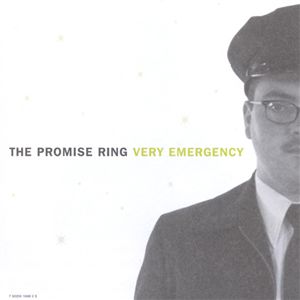
Very Emergency is the third studio album by American rock band the Promise Ring, released on September 28, 1999, through the label Jade Tree. Following the release of their second studio album Nothing Feels Good (1997), bassist Scott Beschta was replaced by Tim Burton. After a van accident, which resulted in a six-week break, Burton was replaced by Scott Schoenbeck. The band recorded their next album at Inner Ear Studios in Washington, D.C., co-producing it with J. Robbins. Very Emergency is a power pop and pop rock album that moves away from the emo style of their earlier works. It continued the sound of the Boys + Girls (1998) EP, and was compared to the work of the Lemonheads, the Pixies, Soul Asylum and the Wedding Present.
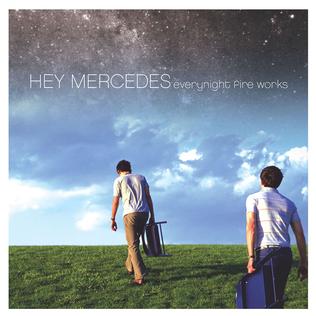
Everynight Fire Works is the debut studio album by American rock band Hey Mercedes. Following the demise of Braid, most of the members formed Hey Mercedes, with guitarist Mark Dawursk joining in early 2000. The band released a self-titled EP through Polyvinyl Record Co., before signing to Vagrant Records at the end of the year. They recorded their debut with Burning Airlines member J. Robbins at Pachyderm Studios in Cannon Falls, Minnesota in April 2001. Everynight Fire Works is an alternative rock, emo, indie rock and pop punk record that drew comparisons to Burning Airlines, Jets to Brazil, and Shudder to Think.
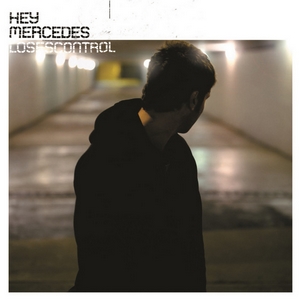
Loses Control is the second and final studio album by American rock band Hey Mercedes. Following the release of Everynight Fire Works (2001), guitarist Mark Dawursk left the band was replaced by Michael Shumaker in May 2002. Between then and the end of the year, the band spent time writing new material. They recorded Loses Control in April and May at Camp Street Studios in Cambridge, Massachusetts with producers Sean Slade and Paul Q. Kolderie. Loses Control is an indie rock, pop-punk and power pop record that used bigger and thicker guitar sounds, and Nanna double-tracking his voice.

Do You Know Who You Are? is the only studio album by American rock band Texas Is the Reason. After finalizing their line-up, they wrote and released their self-titled debut EP in late 1995. Following that, they began recording their debut album at Oz Studios in Baltimore, Maryland, co-producing it with Jawbox member J. Robbins. Preceded by an east coast tour with labelmates Gameface, Do You Know Who You Are? was released on April 30, 1996 through Revelation Records. It was promoted with a European tour with Samiam, two US tours, and a tour of Germany with Queerfish and Starmarket. Shortly after the Germany stint, the group broke up.
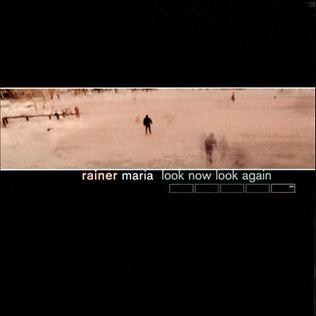
Look Now Look Again is the second studio album by American indie rock band Rainer Maria. It is now regarded as an influential classic of second-wave emo.

"Post Marked Stamps No. 4" is a split EP between Kansas City, Missouri band The Get Up Kids and Chicago, Illinois group Braid. The album is the fourth in the "Post Marked Stamps" series, a set of nine split EPs between various bands put out by Tree Records in 1997. There were 2 different pressings of the album; One distributed in the United States, and another sold in Europe during the band's joint European tour. Each song was recorded separately, with "I'm a Loner Dottie, a Rebel" recorded at Red House Studios in Eudora, Kansas, and "Forever Got Shorter" recorded at Private Studios in Urbana, Illinois. The set included a sealed envelope that contained three postcards; One postcard for each song, including recording information and lyrics, and a third featuring poetry by Vigue Martin.

American Football, also known retrospectively as LP1, is the debut studio album by the American rock band American Football. It was released on September 14, 1999, on the record label Polyvinyl. At the time of recording, the group comprised Mike Kinsella on vocals and guitar, Steve Holmes on guitar, and Steve Lamos on drums. LP1 was recorded in May 1999 at Private Studios in Urbana, Illinois, with production from Brendan Gamble.
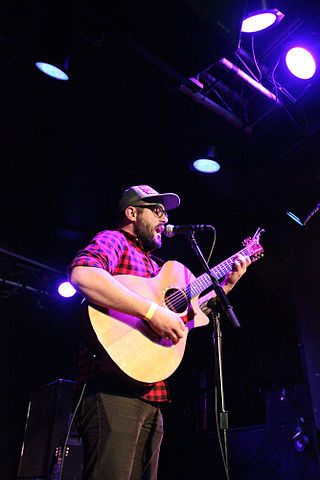
Into It. Over It. is an indie rock band founded in 2007 as the solo project of Chicago, Illinois-based musician Evan Thomas Weiss. It is considered a leading act of the early-2010s emo revival scene.
Midwest emo refers to the emo scene and/or subgenre that developed in the 1990s Midwestern United States. Employing unconventional vocal stylings, distinct guitar riffs and arpeggiated melodies, Midwest emo bands shifted away from the genre's hardcore punk roots and drew on indie rock and math rock approaches. According to the author and critic Andy Greenwald, "this was the period when emo earned many, if not all, of the stereotypes that have lasted to this day: boy-driven, glasses-wearing, overly sensitive, overly brainy, chiming-guitar-driven college music." Midwest emo is sometimes used interchangeably with second-wave emo. Although implied by the name, Midwest emo does not solely refer to bands and artists from the Midwestern United States, and the style is played by outfits across the United States and internationally.

















